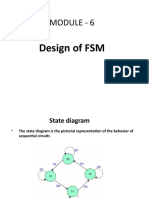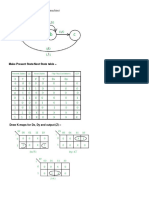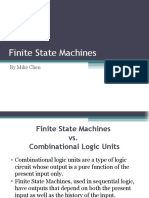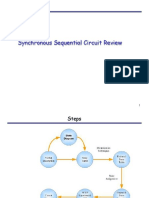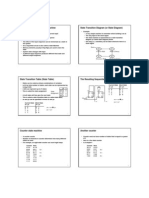FSM Worksheet PDF
FSM Worksheet PDF
Uploaded by
abuzar raoOriginal Description:
Original Title
Copyright
Available Formats
Share this document
Did you find this document useful?
Is this content inappropriate?
Report this DocumentCopyright:
Available Formats
FSM Worksheet PDF
FSM Worksheet PDF
Uploaded by
abuzar raoCopyright:
Available Formats
Finite State Machines Worksheet
Concept Inventory:
• State transition diagrams & FSM truth tables
• Register & ROM implementation
• Equivalent FSMs; equivalent state reduction
• Metastability: causes and cures
Notes:
FSMs are EQUIVALENT if and only if
every inputs sequence yields identical
output sequences.
Two states are equivalent if
1. both states have identical outputs, AND
2. every input transitions to equivalent
states.
Metastability:
Arcs leaving a state must be (1) mutually
exclusive, and (2) collectively exhaustive.
Quarantine time reduces p(metastable)
6.004 Worksheet - 1 of 7 - Finite State Machines
Problem 1.
(A) For each of the following FSMs please indicate if they are or are not well formed. Note that
the state names have been omitted for clarity; you may assume the state names are unique.
(A) (B) (C)
FSM A (circle one): Well Formed / Not Well Formed
FSM B (circle one): Well Formed / Not Well Formed
FSM C (circle one): Well Formed / Not Well Formed
(B) Given the partially completed truth table and FSM diagram below. Complete all the
missing entries in the truth table and the FSM diagram. The FSM is a Moore machine, i.e.,
the Out signal is determined only by the current state. In each state circle, the top entry is
S1S0 and the bottom entry is the value of Out. Make sure that you have labeled all missing
states, inputs, and outputs, and that you have added and labeled any missing transitions in
the FSM.
S1 S0 In S1’ S0’ Out
0 0 0 0
0 0 1 1 0
0 1 0
0 1 1 1 0
1 0 0 1 1 1
1 0 1
1 1 0 0 1 0
1 1 1 0 0 0
(C) If this FSM is implemented using a 2-bit state register and a ROM, what size ROM would be
needed? Please specify the number of locations (entries) of the ROM, and the width of each
entry.
Number of locations in ROM: ___________
Width of each ROM entry (bits): ___________
6.004 Worksheet - 2 of 7 - Finite State Machines
Problem 2.
Consider the sequential logic circuit to
the right, which implements an FSM
with a single data input IN and single
data output OUT. Assume that all
signal transitions are timed so that the
dynamic discipline is satisfied at each
register.
Please describe the operation of the FSM by filling in both the state transition diagram and the
truth table shown below. The two-digit state names in the state transition diagram are S0,S1, the
logic values present at the outputs of REG0 and REG1 after the rising edge of the clock. In the
truth table, S0’ and S1’ are the values that will loaded into REG0 and REG1 at the next rising
clock edge.
Fill in state transition diagram and truth table
S0 S1 IN S0’ S1’ OUT
0 0 0
0 0 1
0 1 0
0 1 1
1 0 0
1 0 1
1 1 0
1 1 1
Problem 3.
A “Thingee” is a clocked device built out of 3 interconnected components, each of which is
known to be a 4-state FSM. What bound, if any, can you put on the number of states of a
Thingee?
Max # of states, or “Can’t Tell”: ________________
6.004 Worksheet - 3 of 7 - Finite State Machines
Problem 4.
Consider the 1-input, 1-output finite state machine with the state transition diagram shown below.
Note that the single output P only depends on the current state of the FSM.
(A) (1 Point) The FSM has been processing inputs for a while and we would like to determine its
current state. After entering three additional inputs “000”, we observe that we have reached
a state where P=0. Please circle the possible values for the state before the additional three
inputs were entered.
Possible values for state before: S1 S2 S3 S4 S5
(B) (2 Points) Assume that the states are represented by the 3-bit binary values given on the left
below. Please fill in the appropriate entries for the partial truth table shown on the right
where S is the current state, I is the input value, S’ is the next state, P is the output value
S I S’ P Fill in partial truth table
State Encoding
S1 001
011 0
S2 010
S3 011 011 1
S4 100
S5 101 100 0
100 1
(C) Please identify which, if any, states are equivalent. For example, if states S1, S2, and S4 are
equivalent, please write “(S1,S2,S4)”. You may need multiple parenthesized lists if more
than one set of states is equivalent.
Equivalent states: _____________________________
6.004 Worksheet - 4 of 7 - Finite State Machines
Problem 5.
Perfectly Perplexing Padlocks makes an entry-level electronic lock, the P3b, built from an FSM
with two bits of state. The P3b has two buttons (“0” and “1”) that when pressed cause the FSM
controlling the lock to advance to a new state. In addition to advancing the FSM, each button
press is encoded on the B signal (B=0 for button “0”, B=1 for button “1”). The padlock unlocks
when the FSM sets the UNLOCK output signal to 1, which it does whenever—and only
whenever—the last 3 button presses correspond to the 3-digit combination. The combination
is unique, and will open the lock independently of the starting state. Unfortunately the design
notes for the P3b are incomplete.
S1 S0 B S’1 S’0 U
1 00
0 0 0 1 1 0
U= U=
0 0 1 0 0 0
0 1 0 1
0
0 1 1 1 0 1
0 1 0 0 0 1 0
0
1 1 0 1 0
U= U= 1 1 0 0
1 1 1 0
(A) (1 Point) What is the 3-bit combination for the lock?
lock combination:_____________________
(B) (5 Points) Using the specification and clues from the partially completed diagrams above
fill in the information that is missing from the state transition diagram and its
accompanying truth table. When done:
• each state in the transition diagram should be assigned a 2-bit state name S1S0 (note
that in this design the state name is not derived from the combination that opens the
lock),
• the arcs leaving each state should be mutually exclusive and collectively exhaustive,
• the value for U should be specified for each state, and
• the truth table should be completed.
(complete above transition diagram and table)
6.004 Worksheet - 5 of 7 - Finite State Machines
Problem 6.
Below is a state transition diagram for a 4-state FSM with a single binary input B. The FSM has
single output – a light that is “on” when the FSM is in states “E” or “S”. The starting state, “W”,
is marked by the heavy circle.
B=0 N B=1
B=0
B=1 B=1
W E
B=1
B=0 S B=0
(A) (1 Point) Does this FSM have a set or sets of equivalent states that can be merged to yield an
equivalent FSM with fewer states?
List set(s) of states that can be merged or write NONE:________________
(B) (5 Points) Please fill in as many entries as possible in the following truth table for the FSM.
The light output is a function of the current state and should be 1 when the light is “on” and
0 when it’s “off.”
S1 S0 B S1’ S0’ light
0 0 0
0 0 1
0 1 0 0 0 1
0 1 1 1 0 1
1 0 0
1 0 1
1 1 0
1 1 1
6.004 Worksheet - 6 of 7 - Finite State Machines
Problem 7.
The following circuit has two inputs (A, CLK) and four outputs (W, X, Y Z). The CLK signal is
square wave with a period tCLK=1us. The A signal makes a single 0→1 transition but the timing
of the transition is close to (within a few ns of) the active CLK edge, ignoring dynamic discipline.
All the devices are lenient and have the same propagation delay tPD=10ns.
In a test involving a large number of trials, the Z output has been examined 100ns after an active
CLK edge (and when both CLK and A have been stable for many propagation delays); at this
time, Z was found to be invalid P times. In the same test, what would you expect to observe at the
other outputs 100ns after the CLK edge? For each output, circle one of
LESS RELIABLE if you would expect the output to be invalid appreciably more than P times;
EQUALLY RELIABLE if you would expect the output to be invalid about P times; or
MORE RELIABLE if you would expect the output to be invalid appreciably less than P
W reliability: LESS EQUAL MORE
X reliability: LESS EQUAL MORE
Y reliability: LESS EQUAL MORE
Z was found to be invalid P times………….
6.004 Worksheet - 7 of 7 - Finite State Machines
MIT OpenCourseWare
https://ocw.mit.edu/
6.004 Computation Structures
Spring 2017
For information about citing these materials or our Terms of Use, visit: https://ocw.mit.edu/terms.
You might also like
- Finite State MachinesDocument16 pagesFinite State MachinesAKASH PALNo ratings yet
- Finite State MachinesDocument8 pagesFinite State MachinesHnd FinalNo ratings yet
- Lab 11Document3 pagesLab 11Ab AbNo ratings yet
- DSD Full TextDocument140 pagesDSD Full TextMaryoom 0X99No ratings yet
- Module - 6Document68 pagesModule - 6Shivanshu TripathiNo ratings yet
- MOD - 6 - FSM - Mealy Model Examples - Nov 9thDocument38 pagesMOD - 6 - FSM - Mealy Model Examples - Nov 9thRavi CharanNo ratings yet
- Tut 3 - FSMDocument2 pagesTut 3 - FSMTay KoonleNo ratings yet
- Sequence DetectorDocument5 pagesSequence DetectoramrutahsapkalNo ratings yet
- Module - 6: Design of FSMDocument69 pagesModule - 6: Design of FSMMohnish KodukullaNo ratings yet
- LECTURE B 1 FSM Minimization IntroDocument18 pagesLECTURE B 1 FSM Minimization IntroBharadwaja PisupatiNo ratings yet
- Finite State MAchinesDocument70 pagesFinite State MAchinesSaksham AnandNo ratings yet
- LECTURE B 1 FSM Minimization IntroDocument18 pagesLECTURE B 1 FSM Minimization IntroAjitBabbanNo ratings yet
- Introduction To State MachineDocument49 pagesIntroduction To State MachineMohammad RafiNo ratings yet
- DS II 2 Finite State MachineDocument42 pagesDS II 2 Finite State MachineNightkiller StationNo ratings yet
- Unit IV Synchronous Sequential Circuits NewDocument28 pagesUnit IV Synchronous Sequential Circuits NewVasanthNo ratings yet
- Tutorial 5 AnswersDocument2 pagesTutorial 5 AnswersM Arif SiddiquiNo ratings yet
- LECTURE B 1 FSM Minimization IntroDocument18 pagesLECTURE B 1 FSM Minimization IntroSathish KumarNo ratings yet
- Finite State Machine DesignDocument7 pagesFinite State Machine DesignlitoduterNo ratings yet
- Lab 6 DLDDocument12 pagesLab 6 DLDitshappyday777No ratings yet
- Synthesis For Finite State MachinesDocument31 pagesSynthesis For Finite State MachinesStalker LokoNo ratings yet
- FSM SlidesDocument37 pagesFSM SlidesSahil Sharma0% (1)
- Tutorial 2 - Electronics (2018)Document3 pagesTutorial 2 - Electronics (2018)Pasindu PramodNo ratings yet
- Algorithm State Machine: Circuits and Control Circuits. Data Path Circuits Perform The Functions Such AsDocument12 pagesAlgorithm State Machine: Circuits and Control Circuits. Data Path Circuits Perform The Functions Such Asabuzar rao100% (1)
- FSM AnswersDocument6 pagesFSM AnswersstudboyNo ratings yet
- SM ChartsDocument20 pagesSM Chartspradeep66100% (4)
- Module 6 - MEALY & MOORE MODELDocument64 pagesModule 6 - MEALY & MOORE MODELGirish Gowtham DevatiNo ratings yet
- Finite State Machines: by Mike ChenDocument25 pagesFinite State Machines: by Mike ChenKulwant NagiNo ratings yet
- Finite State MachinesDocument60 pagesFinite State MachinesAssistance WorldNo ratings yet
- 2-Lecture Notes Lesson4 5Document8 pages2-Lecture Notes Lesson4 5kstu1112No ratings yet
- ECS 154A Midterm KeyDocument4 pagesECS 154A Midterm KeyTiffany LeeNo ratings yet
- FSMDocument55 pagesFSMMazo Ahmed ShiponNo ratings yet
- Quiz - 2Document7 pagesQuiz - 2Ankit GargNo ratings yet
- LectureDocument31 pagesLectureJin LeeNo ratings yet
- Experiment 8Document6 pagesExperiment 8routbismay99No ratings yet
- MIT6 004s09 Quiz02Document6 pagesMIT6 004s09 Quiz02Abhijith RanguduNo ratings yet
- MIT6 004s09 Quiz02 SolDocument6 pagesMIT6 004s09 Quiz02 SolAbhijith RanguduNo ratings yet
- Program: B.Tech Subject Name: CMOS Design Subject Code: EC-603 Semester: 6Document15 pagesProgram: B.Tech Subject Name: CMOS Design Subject Code: EC-603 Semester: 6Reena ShahaNo ratings yet
- Lecture 13Document28 pagesLecture 13Mohd Al AsadiNo ratings yet
- Algorithmic State Machine (ASM) : UnitDocument10 pagesAlgorithmic State Machine (ASM) : Unitateeq mughalNo ratings yet
- Tutorial 02Document4 pagesTutorial 02SathyaNo ratings yet
- Homework 1 Outline of SolutionsDocument7 pagesHomework 1 Outline of SolutionsJeff SchulthiesNo ratings yet
- SeqDesign Review 1Document25 pagesSeqDesign Review 1RAGUL RAJ SNo ratings yet
- DS2022 Lab5Document8 pagesDS2022 Lab5Le minhNo ratings yet
- Cpre 281: Digital Logic: Instructor: Alexander StoytchevDocument123 pagesCpre 281: Digital Logic: Instructor: Alexander StoytchevharithNo ratings yet
- Homework6 AnsDocument12 pagesHomework6 Ansnada abdelrahmanNo ratings yet
- LECTURE B 4 FSM Encoding IntroDocument32 pagesLECTURE B 4 FSM Encoding IntroxxqwertyxxNo ratings yet
- CS 151 Digital Systems Design: Register Transfer LevelDocument17 pagesCS 151 Digital Systems Design: Register Transfer LevelDr-Suraj Kumar SawNo ratings yet
- DLD Lab Report 5Document7 pagesDLD Lab Report 5UMAIR KhanNo ratings yet
- Cs316-Lec3 5Document15 pagesCs316-Lec3 5Gaith RjoubNo ratings yet
- Quiz 1: Solutions: 6.045J/18.400J: Automata, Computability and ComplexityDocument9 pagesQuiz 1: Solutions: 6.045J/18.400J: Automata, Computability and ComplexityAAtroxNo ratings yet
- Sequential Circuit and State Machine State Transition Diagram (Or State Diagram)Document5 pagesSequential Circuit and State Machine State Transition Diagram (Or State Diagram)Harish RamasubramanianNo ratings yet
- Vlsi Testing Fall20 hw2Document3 pagesVlsi Testing Fall20 hw2Salman HadiNo ratings yet
- Finite State MachineDocument29 pagesFinite State MachineA10-14Rajat KumarNo ratings yet
- Sdic IV NotesDocument13 pagesSdic IV NotesPAVETHRA R SNo ratings yet
- Chapter #9: Finite State Machine OptimizationDocument51 pagesChapter #9: Finite State Machine Optimizationఅనిల్ కుమార్ రాజగిరిNo ratings yet
- EE789 AssignmentDocument10 pagesEE789 AssignmentArghya Kamal DeyNo ratings yet
- Analog Dialogue, Volume 48, Number 1: Analog Dialogue, #13From EverandAnalog Dialogue, Volume 48, Number 1: Analog Dialogue, #13Rating: 4 out of 5 stars4/5 (1)
- ECE 311 - Spring 2019 Homework 7 - Electromagnetic WavesDocument1 pageECE 311 - Spring 2019 Homework 7 - Electromagnetic Wavesabuzar raoNo ratings yet
- ECE 305 Homework: Week 4Document2 pagesECE 305 Homework: Week 4abuzar raoNo ratings yet
- Implication Chart - Google Meet PDFDocument7 pagesImplication Chart - Google Meet PDFabuzar raoNo ratings yet
- Asynchronous Sequential Machine Designing Google MeetDocument9 pagesAsynchronous Sequential Machine Designing Google Meetabuzar raoNo ratings yet
- Lec-4 - Asy Seq Machine - Example-2 PDFDocument4 pagesLec-4 - Asy Seq Machine - Example-2 PDFabuzar raoNo ratings yet
- Hazards: Static-0 HazardDocument7 pagesHazards: Static-0 Hazardabuzar raoNo ratings yet
- Lec-5 - Minimization of Incompletely Specified State TableDocument6 pagesLec-5 - Minimization of Incompletely Specified State Tableabuzar raoNo ratings yet
- Algorithm State Machine: Circuits and Control Circuits. Data Path Circuits Perform The Functions Such AsDocument12 pagesAlgorithm State Machine: Circuits and Control Circuits. Data Path Circuits Perform The Functions Such Asabuzar rao100% (1)
- Lec-10 - Stuck at Fault DetectionDocument8 pagesLec-10 - Stuck at Fault Detectionabuzar raoNo ratings yet




